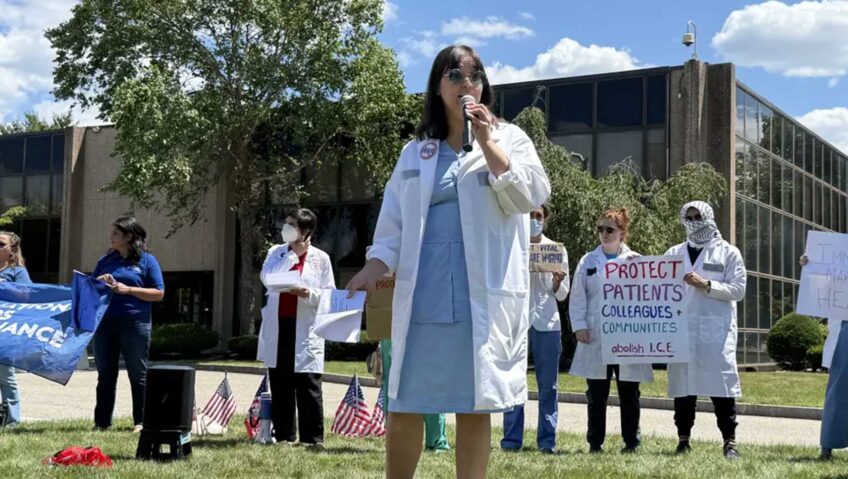Electeds push for debt-free college
Lawmakers anticipate increased funding
As part of the first education plan put forward by a candidate in the 2022 gubernatorial race, democratic hopeful and Massachusetts State Senator Sonia Chang-Diaz has laid out what she calls a “plan for quality, debt-free, universal public education from birth into adulthood,” which includes sweeping reforms across all levels of schooling.
The plan includes endorsements of past legislation such as the Student Opportunity Act which increases funding to public schools for low-income students and which passed in 2019, despite, according to Chang-Diaz, hesitancy from the Baker administration.
In addition, the plan supports proposed measures such as the Debt-Free Future Act to minimize higher education costs and a single-payer universal pre-school modeled after legislation proposed by Chang-Diaz in 2015. Moreover, the eight-page plan shows support for the proposed “Common Start” bill that caps families’ child care expenses at 7% of their income and 0% for certain low-income earners.
“The plan is intended to be comprehensive and really look at that whole system from birth into adulthood so that we have a complete, coherent system and a coherent recognition that education is a public good,” Chang-Diaz said.
The thrust of the early-education-through-12th-grade piece aims to dismantle what Chang-Diaz and many others refer to as the “school to prison pipeline” and looks to create equitable conditions in all Massachusetts public schools.
“The quality of education and often the quantity of education that you get in Massachusetts too often depends on where you live or the color of your skin or what’s in your wallet,” Chang-Diaz said in an interview. “And that is bad for kids, bad for families and bad for our economy.”
The other major piece of the plan looks to extend available education for Bay State residents beyond their senior year of high school.
“Many years ago, very intelligently, we decided that we should educate students for free all the way to 12th grade,” said Claudio Martinez, executive director of Zero Debt Massachusetts, a group that advocates for more affordable higher education. “[We are] asking that we extend that agreement four more years so we can have a population that receives what has become the minimum tools that they will need to be successful.”
Zero Debt and groups like it have been advocating against what they call the “student debt crisis” affecting the nation, especially in Massachusetts. A report by the New England Board of Higher Education (NEBHE) released in 2018 showed the rise in cost to attend a public college in Massachusetts growing at a faster rate than any surrounding state –– while government investment in public higher education has been in decline.
In 2021, the state investment in higher education is lower than it was in 2001. State budget numbers, adjusted for inflation, show that funding is 4.7% less now than it was 20 years ago.
Chang-Diaz claims this money has instead been invested in “prisons, parole and probation,” which have grown in their budgetary allotments alongside other line items such as MassHealth.
According to the 2018 NEBHE report, “state funding cuts were largely caused by budgetary pressure felt by all state programs since the early 2000s” and phased income tax cuts.”
Timmy Sullivan, executive director of the Public Higher Education Network of Massachusetts (PHENOM), points to steep tuition and fees as a way public colleges and universities have filled in the gaps left by state “disinvestment.” According to the Massachusetts Department of Higher Education, average tuition and fees are up more than 20 percent from just five years ago.
“We have really, as a state, relied on this debt-based financing model in a way that is impacting our public college students and making student debt a public college an issue in Massachusetts,” Sullivan said.
He added that faced with tuition hikes and a decline in other funding sources, students have in large part turned to student loans to be able to meet demands.
“Our universities and students are no longer able to rely in the same ways that they previously did on public scholarship in order to pay. So increasingly, we’re having to turn to student loans to afford our education,” he said.
The NEBHE report confirms Sullivan’s sentiment, showing the share of graduates of public universities in Massachusetts who have student loans increasing from 58% in the 2003-4 academic year to 73% in 2015-16.
To reallocate money back into the state education budget is no small feat — advocates like Martinez and Sullivan and politicians like Chang-Diaz concede that the dollar amount (an estimated $2 billion) is pricey, but an important investment into the commonwealth’s economy.
“They’re [already] paying it in the form of forgone wages for families, particularly female-headed households or women who cannot go into the paid workforce because they cannot find child care, and they’re paying it in the form of these massive student debts that they’re carrying,” Chang-Diaz said.
The senator has put forward several revenue streams that could be used to make this plan a reality, including the so-called millionaires’ tax, an endowment tax on private colleges and universities, and “new progressive revenue sources, like closing corporate tax loopholes on offshore multinational profits.”
The millionaires’ tax, officially called the Fair Share Amendment, would create an additional tax of 4% on a person’s annual income above $1 million, and is set to be on the statewide ballot in 2022. The other proposal by Chang-Diaz and supported by debt-free education activists is a 2.5% tax on private university endowments that are over $1 billion.
The earliest that any movement would be made on any portion of the Chang-Diaz’s plan would come when the state Senate reconvenes in January. Beyond that, voters will have to wait and see who wins the vote for the governor’s seat in 2022.
In the meantime, residents like Claudio Martinez of Zero Debt Massachusetts will continue to make pleas for additional support in moving their platform forward.
“To me, [funding education] reaches the level of civil rights when certain populations cannot even dream of obtaining a master’s or a Ph.D. because they cannot afford it,” Martinez said.






